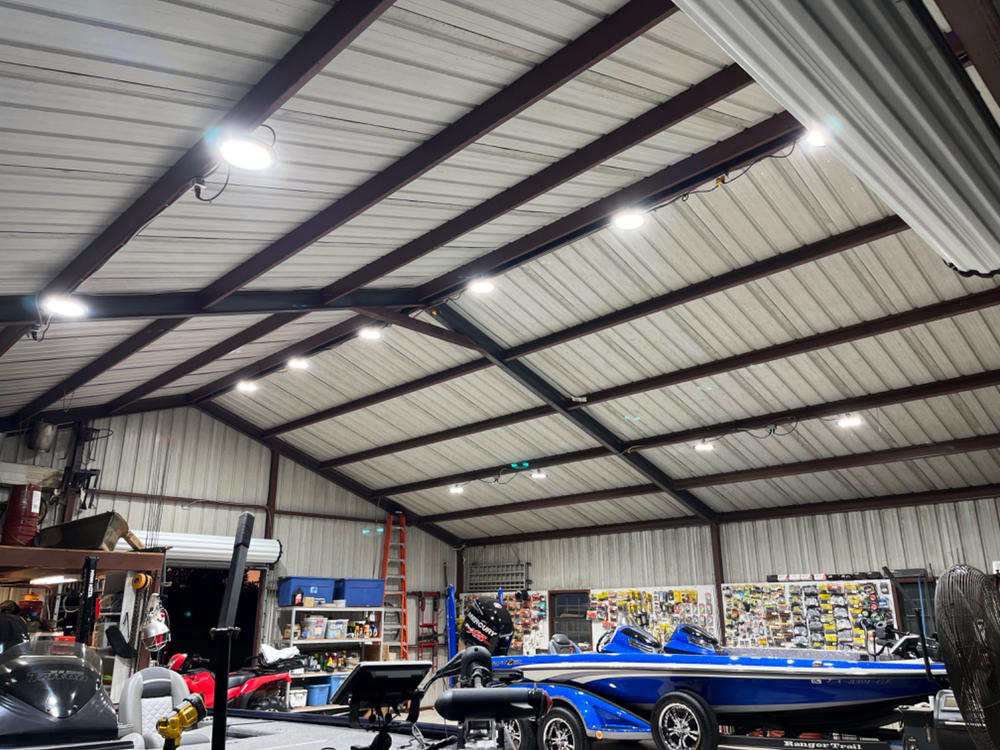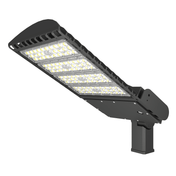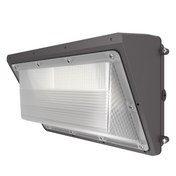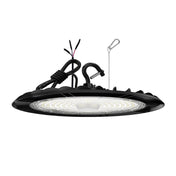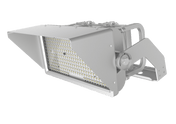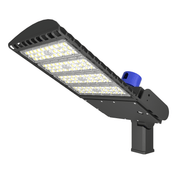How LED High Bay Lights Work
LED high bay lights, a key player in industrial and commercial lighting, operate based on the principle of semiconductor light emission. LEDs, or light-emitting diodes, are solid-state semiconductor devices. Within an LED, a unique semiconductor structure allows electrons to be injected from the N-type semiconductor region into the P-type semiconductor region, where they recombine with holes. During this recombination process, electrons transition from a high energy level to a low energy level, releasing excess energy as photons, thus generating light. This method of light emission is fundamentally different from traditional lamps such as incandescent and fluorescent lamps.
Incandescent lamps generate light by passing an electric current through a filament, heating it to extremely high temperatures (typically between 2000 and 3000°C). This incandescent filament then radiates visible light. During this process, most of the electrical energy is converted into heat, with only a very small portion (about 10%) converted into light energy. This results in extremely low photoelectric conversion efficiency. Furthermore, at high temperatures, the filament tends to evaporate, thin, and eventually burn out, limiting its lifespan to typically 1,000 to 2,000 hours.
Fluorescent lamps utilize the principle of gas discharge. The lamp is filled with mercury vapor and an inert gas. When voltage is applied across the tube, electrons are accelerated by the electric field and collide with mercury atoms, exciting them to a high energy level. When the mercury atoms transition from a high energy level back to a low energy level, they emit ultraviolet light. This ultraviolet light then excites the phosphor inside the tube, which absorbs the ultraviolet light and emits visible light. However, fluorescent lamps require a high voltage to start, and the mercury inside the tube is toxic and potentially harmful to the environment. Their lifespan is typically 8,000 to 15,000 hours.
In contrast, LED high-bay lights utilize a semiconductor light-emitting principle, giving them an inherent advantage in durability. Because they lack vulnerable components like filaments or gas discharge, LED high-bay lights avoid issues like filament burnout and gas leakage, fundamentally improving the fixture's stability and durability. Furthermore, LEDs offer higher luminous efficiency, converting more electrical energy directly into light, reducing energy loss. For the same brightness requirements, LED high-bay lights consume less energy and mitigate various issues associated with heat generation, further ensuring long-term stable operation.
Standards for Measuring LED High-Bay Light Durability
L70 Standard Explanation
The L70 standard is a widely used industry benchmark for evaluating the durability of LED high-bay lights. The L70 standard defines the time it takes for an LED high-bay light's luminous flux to decay to 70% of its initial value as its lifetime. This standard provides a clear boundary for quantifying the durability of LED high-bay lights. For example, an LED high-bay light with a nominal L70 lifespan of 50,000 hours means that under normal operating conditions, its luminous flux will decrease to 70% of its initial value after 50,000 hours.
The L70 standard is crucial in practical applications. The stability and durability of lighting systems are crucial for commercial and industrial spaces. For example, replacing lighting fixtures in large warehouses involves not only the cost of the fixtures themselves, but also labor costs and the cost of interrupting warehouse operations. Using LED high-bay lights with a long L70 lifespan can reduce the hassle and cost of frequent fixture replacements. Assuming a warehouse operates for 3,000 hours per year, a 20,000-hour L70 lamp would need to be replaced approximately every seven years. A 50,000-hour L70 lamp would only need to be replaced approximately every 17 years, significantly reducing maintenance costs and operational impact.
Other Related Standards
In addition to the L70 standard, other standards, such as L50 and L90, are used to measure the durability of LED high-bay lighting. The L50 standard refers to the time it takes for the luminous flux to decay to 50% of its initial value. Because the lighting environment becomes noticeably dim when the luminous flux drops to 50%, it may not meet the needs of most applications. Therefore, this standard is relatively rarely used. However, it does have some value in some specialized applications, such as deep-sea exploration lighting, where brightness requirements are extremely low and replacement costs are extremely high.
The L90 standard indicates the time it takes for the luminous flux to decay to 90% of its initial value, placing higher demands on the durability of lamps. In venues with extremely high light quality requirements, such as museums and high-end art galleries, LED high-bay lamps that meet this standard closely are preferred to ensure exhibits are presented in stable, high-quality light. These venues place stringent demands on light color consistency and stability, and lamps with lower luminous flux decay can better meet these requirements, preventing damage to exhibits or impacting display quality caused by light fluctuations. Different measurement standards are applicable to different application scenarios. Users can select LED high-bay lamps that meet the corresponding standards based on their specific needs, ensuring that the lighting system achieves the best cost-effectiveness and durability while meeting their specific requirements.
Theoretical Durability of LED High-Bay Lights
General Theoretical Lifespan Range
Under ideal conditions, LED high-bay lights exhibit impressive theoretical lifespans, typically ranging from 25,000 to 50,000 hours. This data may seem abstract to some readers, so let's use some simple conversions to make it more intuitive. Assuming a commercial space uses LED high-bay lights for 10 hours per day, then, based on the minimum theoretical lifespan of 25,000 hours, they can last for 2,500 days, or approximately 6.85 years. Using the maximum theoretical lifespan of 50,000 hours, they can last for 5,000 days, or approximately 13.7 years. This means that during normal commercial operations, LED high-bay lights can provide stable lighting for a longer period of time, reducing the inconvenience and cost associated with frequent lamp replacements.
Comparison with Traditional High-Bay Lights
Traditional high-bay lights, such as metal halide and high-pressure sodium lamps, have a significant lifespan difference compared to LED high-bay lights. The average lifespan of a metal halide lamp is generally 8,000-15,000 hours, while that of a high-pressure sodium lamp is typically 10,000-20,000 hours. Assuming 10 hours of daily use, a metal halide lamp can last approximately 2.2-4.1 years, and a high-pressure sodium lamp can last 2.7-5.5 years.
The short lifespan of traditional lamps is primarily due to their operating principles and structural characteristics. During operation, the metal halide within the arc tube corrodes the electrodes at high temperatures. Over time, the electrodes gradually wear out, causing lamp performance to deteriorate and eventually fail. High-pressure sodium lamps, on the other hand, suffer from unstable sodium vapor pressure within the light-emitting tube. Over extended use, the chemical properties of the sodium vapor change, reducing light output and shortening lifespan. Furthermore, the sudden high voltage surge during startup and shutdown of traditional lamps can significantly damage the filament and electronic components, further shortening their lifespan.
LED high-bay lamps, however, have effectively addressed these issues through technological innovation. As mentioned earlier, the semiconductor light-emitting principle of LED high-bay lights eliminates the vulnerable components of traditional lamps, such as filaments and electrodes, reducing the risk of failure and shortened lifespan due to component wear. Furthermore, continuous improvements in LED high-bay light driver technology have enabled them to provide more stable current and voltage, reducing the impact of current fluctuations on the lamps and thus extending their overall lifespan. Furthermore, in terms of heat dissipation design, LED high-bay lights utilize highly efficient heat dissipation materials and structures, such as aluminum alloy heat dissipation housings and heat dissipation fins. These materials effectively dissipate heat generated during operation, preventing increased light decay and device aging caused by high temperatures, further ensuring their stability and durability over extended use.
Factors Affecting the Durability of LED High-Bay Lights
Lamp Bead Quality
Lamp beads are the core light-emitting components of LED high-bay lights, and their quality directly determines the durability of the fixture. High-quality lamp beads are made of meticulously selected materials and craftsmanship. Chip materials typically utilize high-quality materials such as gallium nitride (GaN). These materials offer excellent electrical and optical properties, ensuring stable illumination over extended periods of operation and high luminous efficacy—meaning they produce more luminous flux per unit of electrical energy consumed. For example, lamp beads from renowned brands like CREE and Osram boast high-quality chips that achieve efficient photoelectric conversion, minimizing performance loss due to heat generation and extending the lifespan of the lamp.
The packaging process is also a key factor influencing lamp bead durability. High-quality lamp beads utilize advanced packaging technology and high-temperature and aging-resistant materials, such as silicone. This effectively protects the chip from environmental influences, preventing moisture, dust, and other impurities from entering the bead and causing short circuits or corrosion. At the same time, a good packaging process ensures that the phosphor is evenly coated on the chip, making the light emitted by the lamp more uniform and stable, avoiding problems such as uneven light spots or inconsistent light colors.
In contrast, low-quality lamp beads often cut corners in materials and workmanship. They may use low-quality chips with unstable electrical properties, which easily generate excessive heat during operation, accelerating chip aging and damage. The packaging material may be cheap, low-performance epoxy resin, which easily yellows and cracks in high-temperature environments, losing its protective effect on the chip and significantly shortening the lamp life.
The quality of lamp beads can be judged from multiple aspects. A visual inspection shows that high-quality lamp beads should have a smooth and even package, free of bubbles, cracks, or yellowing, a uniform phosphor coating, and pins that are not oxidized or bent. Low-quality lamp beads, on the other hand, may have packaging defects such as bubbles, cracks, uneven phosphor distribution, rust on the pins, or poor soldering. Conduct electrical performance tests using tools such as a multimeter and a constant-current power supply to measure parameters such as the forward voltage and leakage current of the LEDs. High-quality LEDs have stable forward voltage and leakage current close to zero (in the microampere range). Low-quality LEDs may exhibit high or low voltage and high leakage current. You can also evaluate the LEDs' optical properties, such as brightness, color temperature, and color rendering index. High-quality LEDs have high and uniform brightness, consistent color temperature, a high color rendering index (CRI ≥ 80), and faithful color reproduction. Low-quality LEDs may exhibit low brightness, large color temperature variations, and poor color rendering.
Heat Dissipation Performance
During operation, LED high-bay lights don't fully convert electrical energy into light. Approximately 30%-70% of this energy is converted into heat. If this heat isn't dissipated effectively and promptly, the junction temperature of the LED chip will rise. Excessively high junction temperatures can negatively impact LED performance and shorten its lifespan.
As junction temperature rises, the LED's luminous efficiency decreases, meaning more energy is required to produce the same brightness. This phenomenon is known as "luminous decay." Research shows that for every 10°C increase in junction temperature, the LED's luminous flux can decrease by 10%-20%. Excessively high junction temperatures also accelerate the aging of LED materials, gradually degrading the performance of the chip and packaging materials, ultimately leading to damage. For example, if the junction temperature exceeds 80°C for a long period of time, the LED's lifespan can be shortened by more than half.
To ensure the heat dissipation performance of LED high-bay lights, various common heat dissipation methods are used. Aluminum substrates are a common heat dissipation method. Aluminum substrates offer excellent thermal conductivity, enabling them to quickly conduct heat away from LED chips. They typically consist of a circuit layer, an insulation layer, and an aluminum base layer. The thermal conductivity of the insulation layer determines the efficiency of heat transfer from the circuit layer to the aluminum base layer. Some high-quality aluminum substrates have insulation layers with thermal conductivity values of up to 3-5 W/(m·K), effectively transferring heat to the aluminum base layer, where it is then dissipated through contact with the air.
Heat pipes are also an efficient heat dissipation method. A heat pipe is filled with a fluid. When heated at one end, the fluid rapidly evaporates and becomes a gas. The pressure differential within the pipe causes the gaseous fluid to flow rapidly to the other end. Upon cooling at the other end, it condenses back into a liquid state, releasing its latent heat of vaporization. The liquid then flows back to the heated end through capillary forces or gravity, repeating this cycle for efficient heat transfer. Heat pipes can conduct heat hundreds of times more efficiently than copper of the same size, quickly transferring heat generated by the LED chip to a larger heat dissipation area, thereby reducing chip temperature.
When selecting an LED high-bay light with excellent heat dissipation performance, the first thing to consider is the fixture's heat dissipation structure. A suitable heat dissipation structure should provide a sufficiently large heat dissipation area. For example, large fins increase the contact area with the air and improve heat dissipation efficiency. The shape and arrangement of the fins also affect heat dissipation. Typically, a spacing of 2-5mm between the fins ensures good ventilation and heat dissipation while preventing airflow obstruction caused by too small a spacing. The quality of the heat dissipation material is also important to consider. In addition to the aluminum base plate and heat pipes mentioned above, the heat dissipation housing should also be made of a material with good thermal conductivity, such as aluminum alloy. Its thermal conductivity is generally between 150-250W/(m·K), which effectively conducts and dissipates heat. Some high-end LED high-bay lights also use auxiliary materials such as thermal grease, which is placed between the LED chip and the heat dissipation components to reduce contact thermal resistance and further improve heat dissipation.
Power Quality
As the power source for LED high-bay lights, the quality of the power supply is crucial to the durability of the fixture. Unstable power supply, such as voltage fluctuations and current instability, can damage LED high-bay lights in various ways.
When voltage fluctuates significantly, the voltage applied to the LEDs can exceed their rated range. Excessive voltage causes a sharp increase in the current flowing through the LEDs, instantly overloading them with excessive power. This can cause the LED chips to overheat and burn out, much like a person suddenly overwhelmed by a load far beyond their capacity. When the voltage is too low, the LEDs may not start properly or their light output may become unstable. Prolonged operation at this low voltage accelerates the aging of the LEDs and shortens their lifespan.
Unstable current can also cause serious problems for LED high-bay lights. LEDs are current-driven devices, requiring extremely stable current. Large current fluctuations can cause the LEDs' brightness to fluctuate, resulting in flickering. Flickering not only affects the visual experience but can also cause eye damage if exposed to it for extended periods. Furthermore, frequent current fluctuations can cause frequent shocks to the electronic components within the lamp, accelerating component damage, much like frequent sudden braking and acceleration can damage a car engine.
To ensure stable operation of LED high-bay lights, a constant current source is crucial. A constant current source provides a stable current, ensuring the LEDs maintain their rated current throughout operation and preventing damage from current fluctuations. For example, a high-quality constant current source can maintain a constant current of approximately 350mA across various input voltages, ensuring proper operation and a long lifespan.
When selecting a suitable power supply, first determine the power and output current based on the wattage and number of LEDs in the LED high-bay light. The power supply should be slightly larger than the actual power draw of the LED high-bay light. It's generally recommended to leave a 10%-20% power margin to account for potential transient power fluctuations. Choose a power supply with overvoltage, overcurrent, and short-circuit protection. Overvoltage protection prevents damage to the lamp due to excessive voltage; overcurrent protection automatically shuts off the circuit when the current exceeds the rated value, preventing the lamp from burning out due to excessive current; and short-circuit protection quickly cuts off power in the event of a short circuit, protecting both the lamp and the power supply. Also pay attention to the power supply's conversion efficiency. A high-efficiency power supply converts more electrical energy into effective output power, reducing energy loss and heat generation, and increasing the stability and lifespan of the power supply. Generally speaking, a high-quality LED driver should have a conversion efficiency of at least 85%.
Operating Environment
The operating environment of LED high-bay lights significantly impacts their durability. Different harsh environments can damage the fixtures in various ways.
High-temperature environments significantly increase the heat dissipation challenges of LED high-bay lights. As mentioned earlier, if the heat generated by LEDs cannot be dissipated promptly, the junction temperature will rise, accelerating the aging of the LEDs and other components. When the ambient temperature is high, the temperature difference between the heat dissipating components and the surrounding environment decreases, slowing the heat dissipation rate. This is similar to how it becomes difficult for people to dissipate heat on a hot summer day. For example, near industrial furnaces or in outdoor warehouses with high summer temperatures, ambient temperatures can reach as high as 40°C to 50°C. In such environments, the lifespan of LED high-bay lights can be significantly shortened due to poor heat dissipation.
High-humidity environments can easily cause condensation inside the fixture. Once this condensation enters the fixture, it can short-circuit and damage electronic components. For LED high-bay lights with metal casings, condensation can also cause rust, reducing the casing's protective and heat dissipation capabilities. In high-humidity locations like food processing plants and swimming pools, lamps are exposed to high humidity for extended periods. Without adequate protective measures, malfunctions are likely to occur.
In dusty environments, dust gradually accumulates on and within lamps. Dust accumulated on the surface can affect light transmission and reduce lighting effectiveness, acting like a "veil" over the lamp. Dust that enters the interior of the lamp can block heat dissipation channels, impairing heat dissipation. It can also combine with moisture and corrode electronic components. In dusty industrial locations like mines and cement plants, LED high-bay lights require excellent dust protection to ensure long-term, stable operation.
Strong seismic environments pose challenges to the structural stability of LED high-bay lights. Under strong vibrations, internal components can loosen or fall off, leading to poor circuit connections or damage to the lamp beads. For example, in workshops or construction sites where large machinery operates, LED high-bay lights may be subject to frequent vibrations, requiring them to have a sturdy structure and good seismic design.
The IP rating is a key indicator of an LED high-bay light's adaptability to different environments. Take the IP65 rating as an example. IP stands for Ingress Protection, and the two digits following it represent the dust and water resistance ratings, respectively. The 6 represents complete protection against dust ingress, while the 5 represents protection against water jets. This means that even water sprayed from any direction will not cause any harmful effects. In dusty environments, choose LED high-bay lights with an IP5X rating or higher, where the X represents the dust resistance level; a higher number indicates better dust protection. In environments with high humidity or the possibility of water spray, choose lights with an IPX5 rating or higher, where the X represents the water resistance level. Choosing the appropriate protection level for the specific environment can effectively improve the durability of LED high-bay lights and ensure their proper operation in harsh environments.
Real-World Case Study
Application Cases in Different Industries
1. Factory Floor: An automobile manufacturing plant, with an 8-meter ceiling height, originally used traditional metal halide lamps. On average, numerous lamps needed to be replaced annually, and the lighting performance declined year by year due to severe light decay. This severely impacted workers' accuracy and work efficiency. Later, the factory replaced its lighting fixtures with a well-known brand of LED high-bay lamps. These 150W LED high-bay lamps feature CREE LEDs, large aluminum alloy fins combined with heat pipes for heat dissipation, and a constant current source with overvoltage and overcurrent protection. After five years of operation, testing showed that the luminous flux of these LED high-bay lamps remained above 80% of their initial value. Only a few lamps experienced power failures, which were restored to normal operation after a power supply replacement. This case demonstrates that in environments like factory floors, where lighting stability and brightness are crucial, high-quality LED high-bay lamps, with their exceptional durability, can significantly reduce lamp replacement frequency, lower maintenance costs, and improve production efficiency.
2. Logistics Warehouse: A large logistics warehouse covering 10,000 square meters with a 10-meter ceiling height. Frequent storage and handling of goods within the warehouse necessitates high lighting uniformity and brightness. The warehouse installed a fleet of LED high-bay lights with an IP65 protection rating to withstand the dusty warehouse environment. After four years of operation, the lights have performed remarkably well. Despite the complex warehouse environment, subject to vibration from handling equipment such as forklifts, the luminaires' robust structural design and robust anti-vibration measures have prevented any loosening or damage to components. Only a few lights were damaged by accidental collisions with cargo, but prompt replacement ensured the normal operation of the warehouse lighting. This demonstrates that in complex environments like logistics warehouses, LED high-bay lights, with the appropriate IP65 protection rating and structural design, can provide long-term, stable operation and meet the lighting needs of logistics operations.
3. Stadium: A comprehensive sports stadium is used for various sporting events and daily training. The venue was equipped with high-power LED high-bay lighting. These fixtures not only had to meet high illumination requirements but also possess excellent optical performance to prevent glare for athletes and spectators. After three years of use, the lights' light color consistency remains excellent, with no noticeable color drift. Furthermore, thanks to their efficient heat dissipation system and stable power supply, they maintain high stability and durability despite frequent on-off cycles and prolonged use. During the event, the lights continued to operate normally even under prolonged, high-intensity use, providing an excellent lighting environment for athletes and spectators. This demonstrates the exceptional durability and reliability of LED high-bay lighting, even in venues like stadiums, where lighting performance is crucial.
Case Summary and Lessons
From the above practical cases, we can see that the key factors affecting the durability of LED high-bay lights primarily include lamp quality, heat dissipation performance, power supply quality, and environmental protection. When selecting LED high-bay lights, prioritize well-known brands and products with high-quality lamps to ensure the reliability of the core light-emitting components. Pay attention to the heat dissipation design of the lamps and choose lamps with excellent heat dissipation performance, such as those with large-area heat sinks, heat pipes, and other efficient heat dissipation methods. This ensures timely and effective heat dissipation during operation, reduces junction temperature, and prolongs the lifespan. A stable and reliable power supply is also essential. Choose a constant current source driver with overvoltage and overcurrent protection to ensure stable operation under different voltage and current conditions. Choosing a lamp with the appropriate protection level for the operating environment is crucial. In harsh environments such as dust, high humidity, and vibration, choose LED high-bay lights with high protection levels and sturdy construction to improve the lamp's adaptability to the environment. These lessons learned can provide readers with a valuable reference for selecting and using LED high-bay lights, helping them make more informed decisions and ensure the long-term stability of their lighting systems.
How to Extend the Durability of LED High Bay Lights
Correct Installation Methods
Proper installation methods are fundamental to ensuring the durability of LED high bay lights. Mounting height significantly impacts the lighting performance and durability of the fixture. In typical industrial plants, if the mounting height is too high, while it can illuminate a larger area, the light will be dispersed, resulting in insufficient ground illumination and poor lighting in the work area. Furthermore, excessive mounting heights can hinder heat dissipation, accelerating the aging of the lamp beads and other components. Based on relevant lighting design specifications and practical experience, for industrial plants with a height of 8-10 meters, the recommended mounting height for LED high bay lights is generally between 7-8 meters. This ensures sufficient ground illumination and facilitates heat dissipation.
Mounting spacing is also crucial. If the spacing between fixtures is too large, dark areas will appear in the illuminated area, affecting overall lighting uniformity. However, if the spacing is too small, energy will be wasted and the fixtures may interfere with each other's heat dissipation. Taking a 1,000-square-meter warehouse as an example, using 150W LED high-bay lights, while maintaining a uniform illumination of 300 lux, lighting calculation software simulations indicate that the ideal installation spacing for the fixtures is approximately 3-4 meters. This ensures even and adequate lighting throughout the warehouse.
The installation angle is also crucial. LED high-bay lights typically have a fixed beam angle, such as the common 120° or 140°. During installation, the fixture angle should be adjusted according to actual lighting needs to ensure that light accurately reaches the work area. In warehouses with high shelves, the fixture should be installed at a downward angle to ensure that all levels of the shelves are illuminated. In open production halls, the fixture angle can be relatively horizontal to achieve uniform illumination over a large area.
During the installation process, certain operating procedures must be observed. Before installation, ensure the installation environment is dry and free of dust and corrosive gases to prevent these factors from damaging the fixture. Installers should also wear anti-static gloves to prevent static electricity from damaging the fixture's internal electronic components. When fixing lamps, use appropriate installation accessories, such as expansion bolts, hangers, etc., to ensure that the lamps are installed firmly to avoid loosening or falling due to vibration or external force during use.
Proper Usage Habits
Developing proper usage habits can effectively reduce the wear and tear of LED high-bay lights and extend their lifespan. Frequently turning LED high-bay lights on and off can significantly damage the fixture. Each time they are turned on and off, the driver generates a large current surge, similar to the surge in a car's engine during rapid acceleration. This can damage the lamp beads and the electronic components in the driver. Studies have shown that frequent on-off cycles can shorten the lifespan of LED high-bay lights by 20%-30%. Therefore, in practice, unnecessary on-off cycles should be minimized. When people briefly leave the illuminated area, the lights can remain on. For areas unoccupied for extended periods, timers or motion sensors can be set to automatically turn on when someone enters and off after a delay.
Controlling usage time is also crucial. Although LED high-bay lights have a long theoretical lifespan, prolonged continuous use can cause them to overheat, accelerating the aging of the lamp beads and other components. In some factory workshops, lights may operate 24/7, placing a significant strain on their durability. To extend the life of lamps, lighting schedules should be arranged appropriately, such as by rotating the lamps at different times to avoid prolonged continuous use.
Avoiding overloading is also crucial. LED high-bay lights have specific power and current ratings. Overloading can overload the electronic components within the fixture, causing them to overheat and damage. For example, if a 100W rated LED high-bay light is connected to a power source exceeding its rated power, the lamp beads may burn out instantly. During operation, ensure that the power supply parameters match the rated parameters of the lamp. Do not arbitrarily replace high-wattage bulbs or change the circuit connection method.
Regular Maintenance
Regular maintenance is crucial to maintaining the optimal performance and extending the life of LED high-bay lights. Regular cleaning of the fixtures is essential. Dust easily accumulates on the fixture surface and heat sink fins, affecting heat dissipation and light transmission. Dust covering the heat sink fins acts like a thermal barrier, hindering heat dissipation, causing internal temperatures to rise and accelerating the aging of the lamp beads. It is generally recommended to clean the fixtures quarterly. To clean, first turn off the power and allow the fixture to cool. Then, gently wipe the fixture surface with a soft, dry cloth or a cloth lightly dampened with a mild detergent. Be careful not to use detergents containing corrosive ingredients, as these may damage the fixture housing. Dust on the heat sink fins can be removed with a compressed air spray gun or a small vacuum cleaner.
Checking wiring connections is also an important part of maintenance. After prolonged use, the power cord and internal connectors may become loose, deteriorate, or become damaged. Loose cables can cause poor contact, causing the lamp to flicker or go out. Aged and damaged wiring can cause short circuits, damaging the lamp and even leading to safety hazards. Wiring connections should be inspected monthly to check for loose wiring, damaged casing, and oxidation at the joints. If any problems are found, tighten any loose joints and replace any aged or damaged wiring.
Luminous flux testing is a key method for evaluating the performance of LED high-bay lights. With age, the luminous flux of LED high-bay lights gradually decreases. Regular luminous flux testing provides a timely understanding of changes in lamp performance, allowing for timely replacement or other measures when luminous flux degradation reaches a certain level. It is generally recommended to test lamps annually using professional luminous flux testing equipment. When luminous flux decays to approximately 80% of its initial value, the lamp will still function properly, but the lighting effect will be significantly reduced. At this point, it is necessary to consider replacing the lamp or increasing the number of lamps to meet lighting needs. Through correct installation methods, reasonable usage habits and regular maintenance, the durability of LED high bay lights can be effectively extended, allowing them to provide high-quality lighting services for various places stably for a long time.
Conclusion
LED high-bay lights, with their unique semiconductor light-emitting principle, offer numerous advantages in durability, boasting a long theoretical lifespan, far exceeding that of traditional high-bay lights. However, their durability is influenced by a combination of factors, including lamp quality, heat dissipation, power quality, and operating environment. High-quality lamps, efficient heat dissipation systems, stable power supplies, and effective protective measures are key to ensuring the long-term, stable operation of LED high-bay lights.
Through real-world case studies, we have demonstrated that, in diverse industry applications, LED high-bay lights can demonstrate excellent durability by carefully considering these factors during selection and use, providing reliable support for the lighting needs of various industries. To further extend the durability of LED high-bay lights, proper installation methods, appropriate usage habits, and regular maintenance are essential. These combined efforts can effectively reduce lamp wear and maintain optimal performance.
With the continuous advancement of technology, the durability of LED high-bay lights is also evolving. In the future, we can expect to see further optimization of LED materials and processes, innovative breakthroughs in heat dissipation technology, and continuous improvement in power supply stability. These will push the durability of LED high-bay lights to a new level, enabling them to play an even more important role in industrial and commercial lighting, creating a more stable and efficient lighting environment for people.

